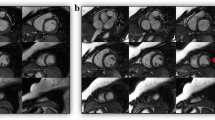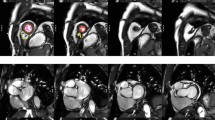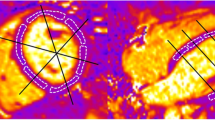Abstract
Purpose
We aimed to investigate comparability of LV volumes, function, and mass acquired with three steady-state free precession (SSFP) pulse sequences, simulating typical vendor and protocol specific differences in data acquisition.
Methods
Twenty-one healthy subjects (11 male and 10 female; age range 23–49) underwent cardiac magnetic resonance (CMR) imaging at 1.5 Tesla (T). A complete stack of short-axis views covering the entire left ventricle (LV) were acquired for each of the three SSFP sequences, differing in the interslice gap and slice thickness (7 mm with no gap (7/0 mm); 7 mm with a 3 mm gap (7/3 mm) and 6 mm with a 4 mm gap (6/4 mm)) with slight variations in acquisition parameters. For each sequence, the LV volumes, function, and mass were determined. Intra- and inter-observer variability and inter-study reproducibility were assessed for all protocols.
Results
All LV volumes, function and mass parameters were similar for the three SSFP sequences (P > 0.05 for all). The LV ejection fraction for the 7/3 mm sequence was 67.2 ± 6.0, 67.4 ± 5.3 for the 7/0 mm sequence, and the 6/4 mm sequence was 69.2 ± 5.7. The LV mass ranged from 119.8 ± 32.4 for the 7/3 mm sequence to 122.2 ± 34.0 for the 7/0 mm sequence. Variabilities were low with no difference in variability between the sequences.
Conclusion
The three SSFP pulse sequence techniques resulted in similar LV volume, function, and mass measurements with no difference in observer and interstudy variabilities. This may allow application and transfer of LV volume studies and databases based on different imaging parameters, at different CMR sites, with a given post-processing method. Future multi-centre studies may now be in a position to consider multi-vendor study designs for LV volume studies.


Similar content being viewed by others
Abbreviations
- ANOVA:
-
Analysis of variance
- CMR:
-
Cardiovascular magnetic resonance
- CoV:
-
Coefficient of variability
- FLASH:
-
Fast low angle shot
- MRI:
-
Magnetic resonance imaging
- T:
-
Tesla
- TE:
-
Echo time
- TR:
-
Repetition time
- LV:
-
Left ventricle
- SD:
-
Standard deviation
- SSFP:
-
Steady-state free precession.
References
Alfakih K, Plein S, Thiele H, Jones T, Ridgway JP, Sivananthan MU. (2003) Normal human left and right ventricular dimensions for MRI as assessed by turbo gradient echo and steady-state free precession imaging sequences. J Magn Reson Imaging 17:323–329
Grothues F, Smith GC, Moon JC, Bellenger NG, Collins P, Klein HU, et al (2002) Comparison of interstudy reproducibility of cardiovascular magnetic resonance with two-dimensional echocardiography in normal subjects and in patients with heart failure or left ventricular hypertrophy. Am J Cardiol 90:29–34
Moon JC, Lorenz CH, Francis JM, Smith GC, Pennell DJ (2002) Breath-hold FLASH and FISP cardiovascular MR imaging: left ventricular volume differences and reproducibility. Radiology 223:789–797
Di Cesare E, Catalucci A, Masciocchi C (1999) Left ventricular function: MRI assessment. Rays 24:19–32
Bellenger NG, Davies LC, Francis JM, Coats AJ, Pennell DJ. (2000) Reduction in sample size for studies of remodeling in heart failure by the use of cardiovascular magnetic resonance. J Cardiovasc Magn Reson 2:271–278
Darasz KH, Underwood SR, Bayliss J, Forbat SM, Keegan J, Poole-Wilson PA, et al (2002) Measurement of left ventricular volume after anterior myocardial infarction: comparison of magnetic resonance imaging, echocardiography, and radionuclide ventriculography. Int J Cardiovasc Imaging 18:135–142
Mao S, Takasu J, Child J, Carson S, Oudiz R, Budoff MJ (2003) Comparison of LV mass and volume measurements derived from electron beam tomography using cine imaging and angiographic imaging. Int J Cardiovasc Imaging 19:439–445
Kunz RP, Oellig F, Krummenauer F, Oberholzer K, Romaneehsen B, Vomweg TW, et al (2005) Assessment of left ventricular function by breath-hold cine MR imaging: Comparison of different steady-state free precession sequences. J Magn Reson Imaging 21:140–148
Fieno DS, Jaffe WC, Simonetti OP, Judd RM, Finn JP. (2002) TrueFISP assessment of accuracy for measurement of left ventricular mass in an animal model. J Magn Reson Imaging 15:526–531
Shors SM, Fung CW, Francois CJ, Finn JP, Fieno DS (2004) Accurate quantification of right ventricular mass at MR imaging by using cine true fast imaging with steady-state precession: study in dogs. Radiology 230:383–388
Sandstede J, Lipke C, Beer M, Hofmann S, Pabst T, Kenn W, et al (2000) Age- and gender-specific differences in left and right ventricular cardiac function and mass determined by cine magnetic resonance imaging. Eur Radiol 10:438–442
Hudsmith LE, Petersen SE, Francis JM, Robson MD, Neubauer S (2005) Normal human left and right ventricular and left atrial dimensions using steady state free precession magnetic resonance imaging. J Cardiovasc Magn Reson 7:775–782
Lorenz CH, Walker ES, Morgan VL, Klein SS, Graham TP (1999) Jr Normal human right and left ventricular mass, systolic function, and gender differences by cine magnetic resonance imaging. J Cardiovasc Magn Reson 1:7–21
Bland JM, Altman DG (1986) Statistical methods for assessing agreement between two methods of clinical measurement. Lancet 1:307–310
Selvanayagam J, Westaby S, Channon K, Francis J, Eichhofer J, Saito S, et al (2003) Images in cardiovascular medicine. Surgical left ventricular restoration: an extreme case. Circulation 107:e71
Danilouchkine MG, Westenberg JJ, de Roos A, Reiber JH, Lelieveldt BP (2005) Operator induced variability in cardiovascular MR: left ventricular measurements and their reproducibility. J Cardiovasc Magn Reson 7:447–457
Acknowledgement
This study was supported by grants from the British Heart Foundation (SEP, LEH, SN), the Medical Research Council (MDR), the Wellcome Trust (SN) and the Rhodes Scholarship (MCH).
Author information
Authors and Affiliations
Corresponding author
Rights and permissions
About this article
Cite this article
Hogan, M.C., Petersen, S.E., Hudsmith, L.E. et al. Effects of steady state free precession parameters on cardiac mass, function, and volumes. Int J Cardiovasc Imaging 23, 583–589 (2007). https://doi.org/10.1007/s10554-006-9191-7
Received:
Accepted:
Published:
Issue Date:
DOI: https://doi.org/10.1007/s10554-006-9191-7




